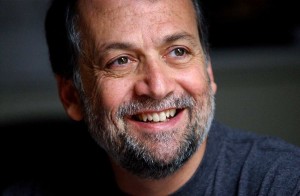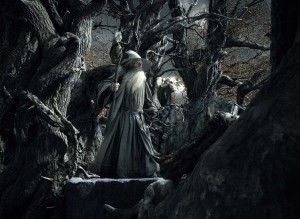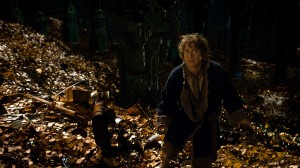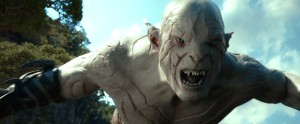
If doing a prequel film to a wildly popular trilogy from 10 years past seems as easy as dusting off old artwork, sets and rebooting computer files, think again. “The technology has changed pretty much completely from what we did on Lord of The Rings,” said visual effects supervisor for the new Hobbit trilogy, Joe Letteri. “What we got mostly came through in the first Hobbit film – bringing Gollum and Rivendell back – we based it on those designs.”
Of course, Letteri is speaking of the new film, The Hobbit: The Desolation of Smaug, but that situation of total renewal likely exists for visual effects supervisors on every 21st century project. “Something fairly major tends to change on every film,” Letteri reflected. “Back on Lord of The Rings, we were doing motion capture but only capturing body. We did facial capture for King Kong. For Avatar we put the two together – performance capture. We did it on a real live-action set with Rise of The Planet of the Apes. On these films, we’ve brought all of that together – using all the tricks.”

Surely one challenge that Letteri and his teams at Weta Digital and Weta Workshop had not previously faced was the introduction of a character as complex and intricately realized as the titular Smaug. Enter the dragon – a wholly new cinematic entity for Letteri and company. “The thing that helped us the most was having all of this background in character animation – being able to understand how to transfer human characters into digital characters,” he explained. “Taking all of that, and what we did on the last film with the Goblin King and with Azog, and applying it to this huge dragon – making a monster into a character.”
With the manifestation of Smaug foremost on the minds of Letteri and his considerable crews, they decided again to base the character, albeit an animal-esque creature, on a human performance. “We worked with Benedict Cumberbatch and put him in a motion-capture suit and a facial camera,” Letteri explained. “We couldn’t take that performance 1:1 and drive Smaug, but we could look at the intent and re-create what Benedict what doing and use that to create Smaug as a performer.”
 Nonetheless, with the considerable physiological differences between the human face and body and that of a dragon, Cumberbatch’s bodily and facial performances were, in the end result, merely reference for Weta Digital’s artists. “We wound up having to key-frame animate it all,” stated Letteri. “Peter Jackson directed him on the motion-capture stage and we had the whole performance beginning to end. The trick came in to apply that to Smaug’s character. To take something like the human jaw motion to apply to Smaug proportionately, it wouldn’t work. What we did is used the intent shot-by-shot and figured out which muscles in Smaug’s face to isolate to get that performance. We created the idea that you were looking at a performance that you could understand. It goes back to everything that we learned on the first film.”
Nonetheless, with the considerable physiological differences between the human face and body and that of a dragon, Cumberbatch’s bodily and facial performances were, in the end result, merely reference for Weta Digital’s artists. “We wound up having to key-frame animate it all,” stated Letteri. “Peter Jackson directed him on the motion-capture stage and we had the whole performance beginning to end. The trick came in to apply that to Smaug’s character. To take something like the human jaw motion to apply to Smaug proportionately, it wouldn’t work. What we did is used the intent shot-by-shot and figured out which muscles in Smaug’s face to isolate to get that performance. We created the idea that you were looking at a performance that you could understand. It goes back to everything that we learned on the first film.”
To the lay observer, a character such as Smaug might include tens of thousands of individual pieces. That assumption would fall far short of what it took Weta Digital’s model builders to construct the character – millions of individual polygonal shapes were required to assemble the full model. “We worked on him for most of the year,” said Letteri. “We had him in the first film destroying Erebor, but we had to rebuild him for this film. We changed his design. He was a four-legged creature in the first film. To do the performance properly [in the new film], he needed two legs with the wings attached to his hands.”
 In four months of dragon model building at Weta Digital, others artists simultaneously recorded body performance and facial performance. Then, over the last six months of postproduction on the film up until its release, Letteri’s team was into full-on effects production, creating all of the major visual effects work for the screen. “You have a dozen core people getting him [Smaug] ready – building the model, the skeletal rig, getting the textures and shaders right, getting the facial rig working,” Letteri noted. “Once you get into producing the shots, there’s another team of 40-50 people working on the animation, lighting the shots, and getting them simulated. We had 1,000 people working on this show just in Weta Digital.”
In four months of dragon model building at Weta Digital, others artists simultaneously recorded body performance and facial performance. Then, over the last six months of postproduction on the film up until its release, Letteri’s team was into full-on effects production, creating all of the major visual effects work for the screen. “You have a dozen core people getting him [Smaug] ready – building the model, the skeletal rig, getting the textures and shaders right, getting the facial rig working,” Letteri noted. “Once you get into producing the shots, there’s another team of 40-50 people working on the animation, lighting the shots, and getting them simulated. We had 1,000 people working on this show just in Weta Digital.”
If building and animating Smaug was the film’s greatest task, other non-dragon challenges for Letteri included digital simulating over a billion coins for a gigantic treasure room scene, which could include 100,000 coins moving within one shot, one of 1951 visual effects shots in the movie. “I like doing shows like this,” said the veteran effects artist. “There is a lot to sink your teeth into creating all these worlds. It gets bigger and bigger each time.”





